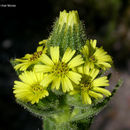en
names in breadcrumbs


Madia sativa, known by the common names coast tarweed[1][2] and Chilean tarweed, is a species of flowering plant in the family Asteraceae found in parts of western North and South America.
Madia sativa is native to the Americas, where it is distributed in two main areas:
The plant grows in many types of habitats, including disturbed areas. In western North America it is most common on coastal grasslands and nearby areas.
Madia sativa is an annual herb varying in size from 20 centimeters tall to well over two meters, the leafy stem branching or not. It is coated densely in sticky resin glands and it has a strong scent. The hairy leaves are linear or lance-shaped, the lowest up to 18 centimeters long.
The inflorescence is generally a cluster of flower heads lined with bristly, glandular phyllaries. Each head bears approximately 8 yellowish ray florets a few millimeters long around a center of several disc florets tipped with dark anthers.
The fruit is a flat, hairless achene with no pappus. This plant has been grown for its seed oil.[3]
Madia sativa, known by the common names coast tarweed and Chilean tarweed, is a species of flowering plant in the family Asteraceae found in parts of western North and South America.